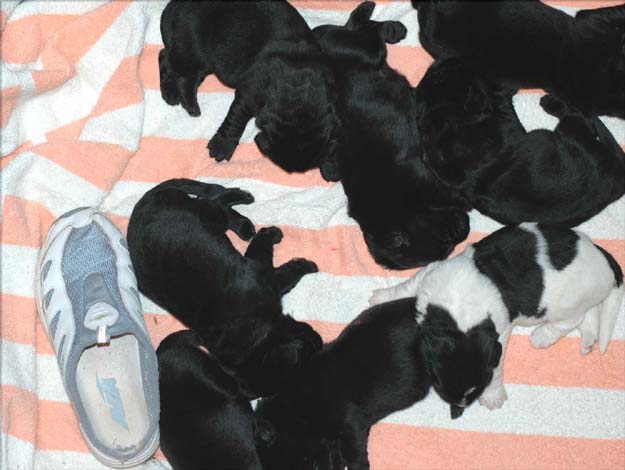
Chapter Three
One Week Old
Newborn puppies are enchanting to look
at. But one-week-old puppies have personality.
You can start to see glimmers of the adult bodies and behaviors
they will grow into.

At a week old, the pups have gained around a pound, and they look twice as big. They still spend many hours napping. Their eyes and ears are still sealed shut. Judi and Ellis are still camping out in the whelping room around the clock, taking turns watching over the litter. There’s probably no need for constant surveillance; good mother dogs are eminently careful and know how to raise a litter. But the whelping room is warm, cozy, and filled with contented puppies, and the Adlers enjoy this happy time.
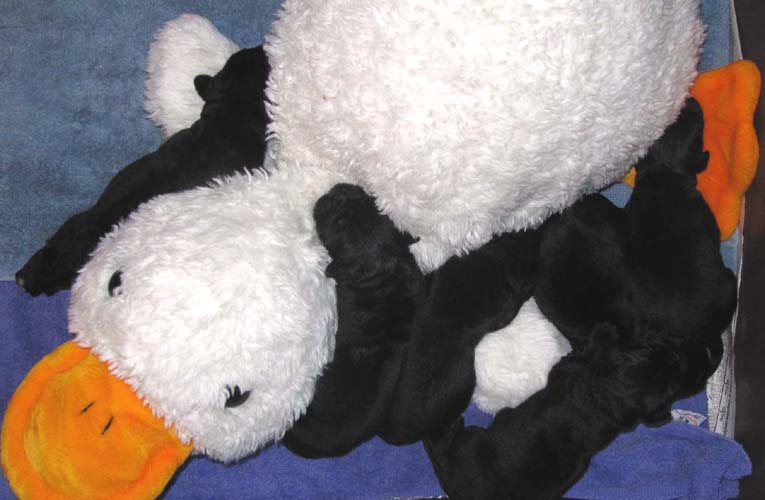
The puppies rarely curl up next to their mom to nap any more. It’s simply too hot there. Instead, they make tracks for the nearest stuffed toy, find a vacant spot, and get comfortable. The duck’s wings and feet make excellent pillows – and someone always curves his body over the duck’s neck.
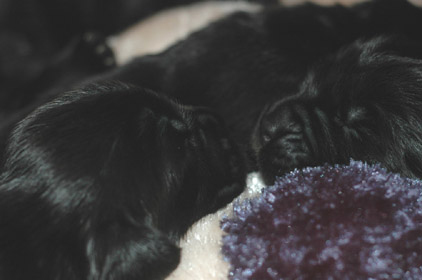
As they enter their second week, changes come daily. Pronounced wrinkles mark each muzzle. The jagged edges on their tongues smooth out. Newborn pups are sleek as seals, but week-old Newfie fur begins to fluff out, feeling like the softest velvet. Toenails are tiny and razor sharp. Trimming them every couple of days protects the mother’s tender mammary area. Let’s see. Eighteen toenails per pup, times how many pups? Right. Judi does a lot of toenail trimming.
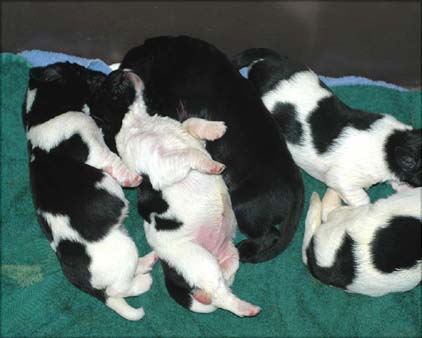
Healthy puppies twitch every few seconds. Their front legs jerk; their back legs kick. Sometimes, they look like they are dancing.
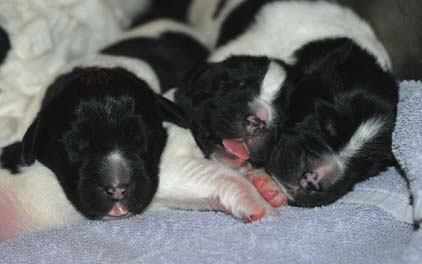
Landseer pups have pink-and-black noses, and very pink pads on their feet. Their noses will gradually turn all black. Those pink pads, though – they stay pink.
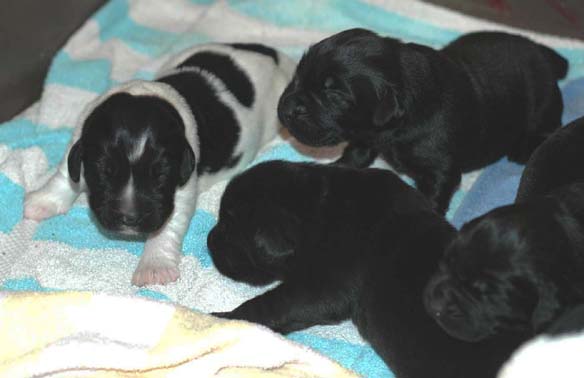
The active pups have been belly-crawling from one end of the whelping box to the other since birth. Now, they lift up those heavy heads and take their first actual steps. “Lurching” is a more accurate description than walking. Big beach towels provide good traction for wobbly legs.
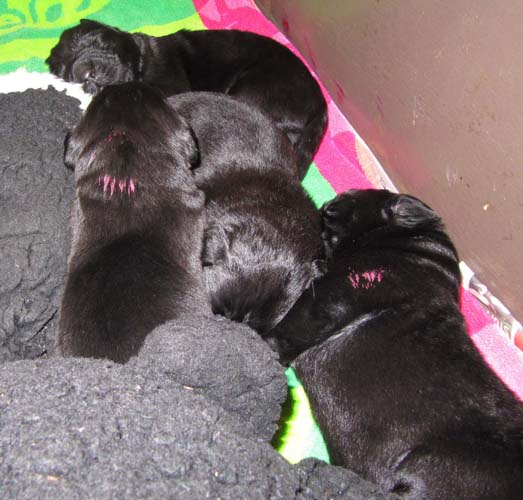
Judi and Ellis continue their supervision, interacting with the puppies pretty much continually. The puppies are weighed daily. If a puppy has lost weight rather than gained, he gets extra attention for the next day or two, until he’s back on track. At each meal, Judi or Ellis help him choose a productive nipple, and they defend his position, making sure the stronger puppies don’t dislodge him before he has had his fill.
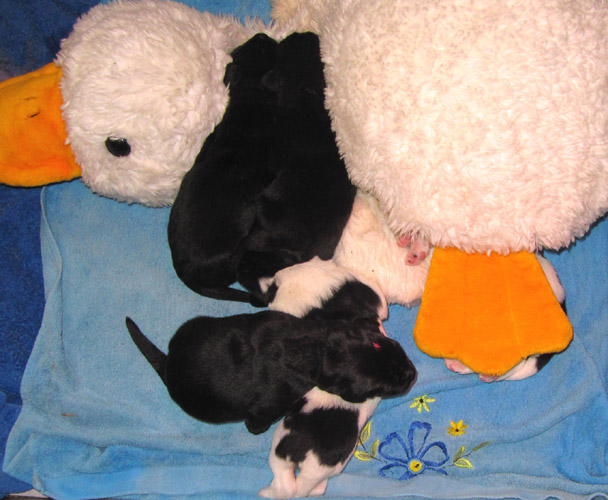
The big stuffed toys continue to be a popular hangout at naptime.
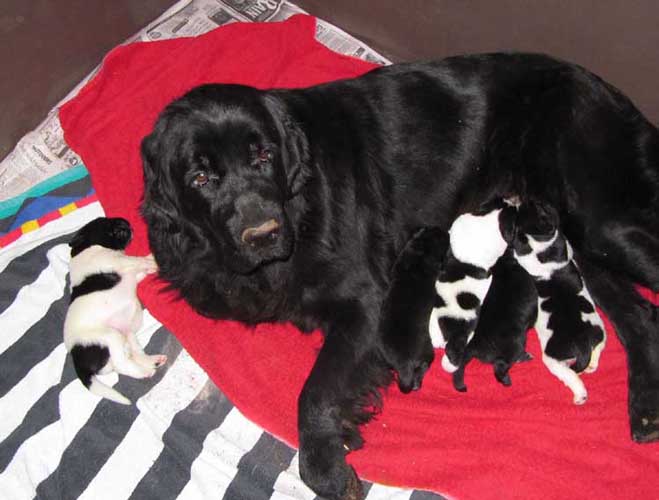
A good mother is such a blessing. Her
body is designed for perfect food dispensing. When puppies latch
on to nurse, they punch and pummel her mammary area with their
paws, grunting and bunting her with their noses. Nothing much
comes out at first, just tantalizing little dribbles. When her
milk does let down, it does so in a rush - a phenomenon every
human mother who has nursed a baby understands intimately. All
that kneading of paws stops instantly. The puppies stiffen their
front legs, arch back, intensify their hold on the nipples with
those clever tongues, and inhale the milk as fast as they can.
All too soon, the heavy milk flow stops, first to one teat, then
another. The puppies are quick to react. They pop off and
hurriedly push their way to a new spot, hoping to find a nipple
that’s still flowing lavishly. The pups with full tummies
will soon crawl away and fall fast asleep. (Because the mom lets
down a specific quantity of milk and then it ceases, greedy
puppies can’t overfill their bellies. This prevents them
from getting painful cramps or colic.) The pups who are still
hungry stick around, switching nipples in search of more food.
Shortly, the milk lets down once more, allowing the still hungry
babies to add a little more nourishment to their bellies.
Every day, it takes a little longer for the milk to let down. By
now, it might take four or five minutes of avid sucking and
active paw-kneading to get the meal on the table. Because they
have to put forth more effort, the pups get more exercise,
strengthening their muscles. (Perhaps it even teaches them that
working hard brings wonderful rewards, a lesson that is
invaluable when their eventual owners introduce them to a
training regime.) And every day, the mother produces a little
more milk, perfectly matching the puppies’ growing
nutritional needs.
Did you note the mom’s brown nose? She’s still
convinced she can sneak those babies out to that wonderful cave
she’s been working on, the one under the rhododendrons. P.S.
She’s still wrong.
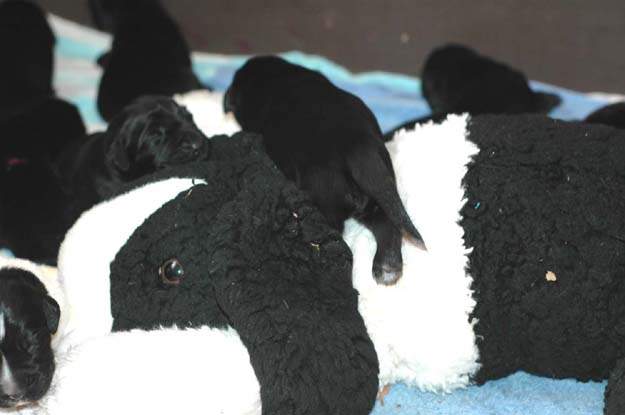
The stuffed toys aren’t just good for naptime. They are also popular during the pups’ play-times. Stuffies make great jungle gyms. The pups enjoy climbing up one side, cresting the hill – and sliding down the other side.
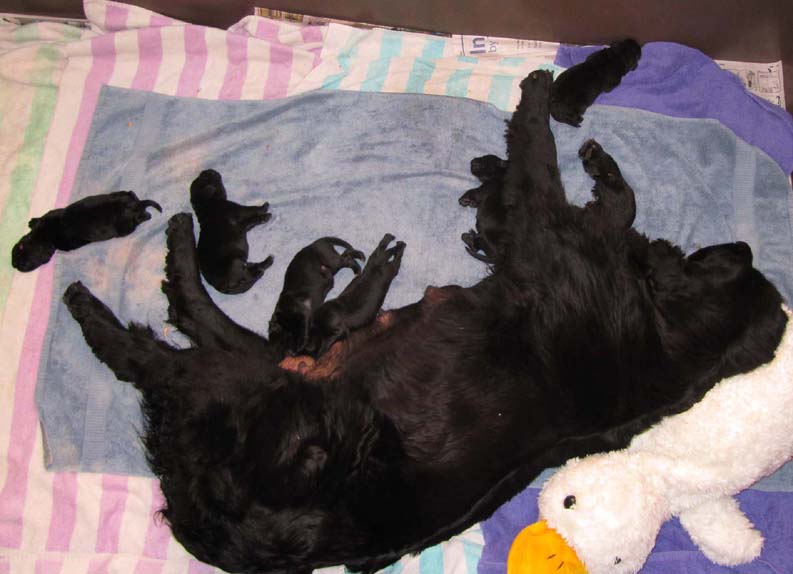
The mother dog appreciates those stuffies, too. It makes a cushy pillow for her head, as she relaxes and nurses her crew.
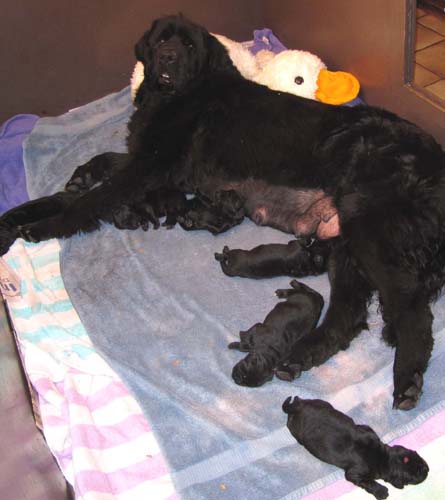
A good mother instinctively knows when her pups need to be fed again, and she heads into the whelping box on her own, taking care not to step on a baby. Sweetbay pups are fast and zoomy, especially when they are hungry and they can smell their mother. So she has to pick her spot and flop down quickly.
Every whelping book recommends the installation of pig rails in the whelping box. A pig rail is a wide board rim that extends around the inside perimeter of the whelping box, making a kind of low shelf that sits six or eight inches off the ground. The purpose is to prevent the mother from accidentally smothering or squashing a baby against the side of the whelping box. (In theory, the rail keeps the mom’s body away from the walls, and the babies can sleep safely underneath the pig rail.) Ellis and Judi dutifully installed pig rails in their first whelping box. But Sweetbay moms are intensely careful, always aware of the location of each tiny puppy, and it soon became apparent that the rails were superfluous.
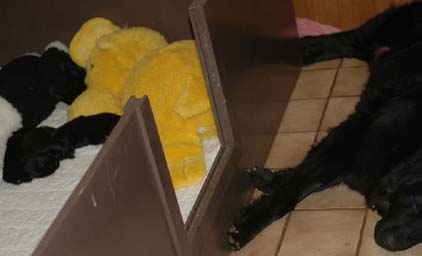
Sweetbay moms are in charge of the whelping box, and they embrace the responsibility. When the pups are newborn, the mom spends every minute in the box with them, and she has to be lured out. Often, it takes a leash and some serious human muscle to get her to leave them for even a moment. But day by day, the mom is more willing to absent herself, and she often naps just outside the whelping box. Close enough to step in if necessary, yet far enough away to begin to give them a little independence.
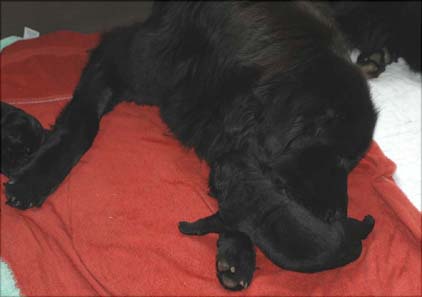
When the pups are only a few days old, they begin eliminating on their own. Amazingly, they scoot away from their resting spot to do so. Judi and Ellis keep the whelping box immaculate, replacing newspapers and towels many times a day. (Their meter reader told Judi that he always knew when they had a new litter, because their electric bill would spike. It was all those towels in the washer and dryer.)
The mother dog no longer has to lick them to stimulate them to eliminate. Now, she just cleans them up afterwards. A good mom will help keep the whelping box clean. She does this by ingesting the feces. Yes, it’s gross. But that behavior has a crucial purpose. In the wild, litters are raised in a small, dug-out den. If the mom did not clean up the pups’ nest, it would soon be a sea of fecal matter. That would pose a health hazard to the pups, and the smell would attract predators.
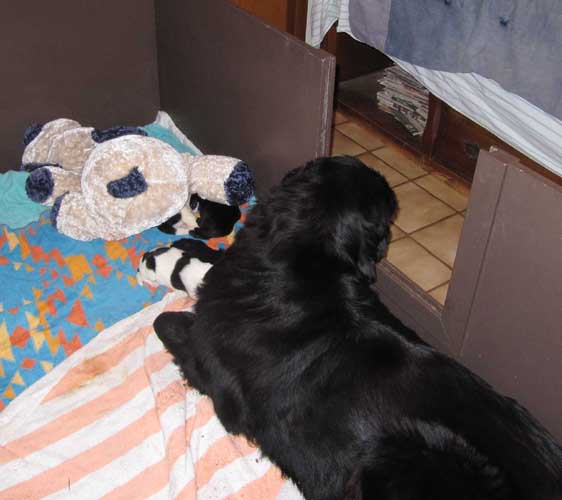
At first, the mom is alert to every unusual noise, and wary of anyone whose voice or footstep she doesn’t recognize. Gradually, though, she relaxes, and by the time the pups are eight or ten days old, she’s ready for company. Truth is, she’s delighted to have company. At Sweetbay, the intense socializing starts when the mom says it’s time. From that point forward, invited visitors come daily, to cuddle, carry, talk to, and play with the pups.
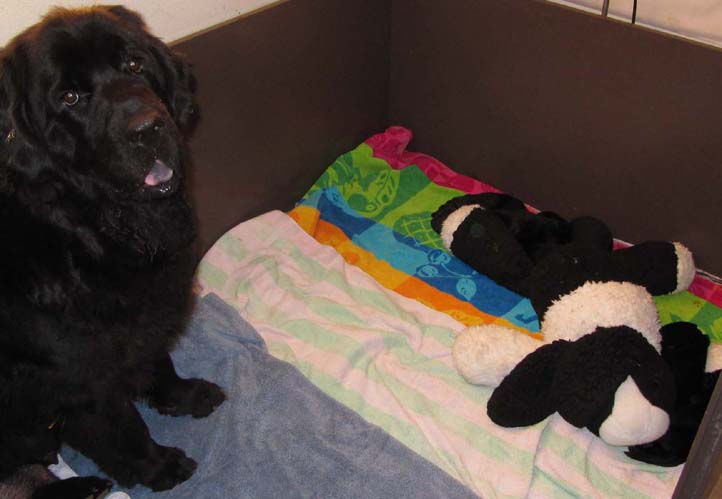
Sweetbay moms are thrilled to show off their babies. Judi jokes that the price of admission is set by the mother, and it always specifies “unlimited petting and lavish compliments” to the mom.
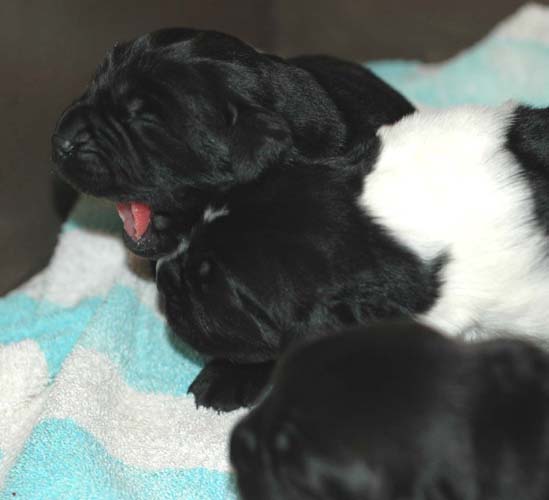
At a week old, the pups still spend very little time awake. If they aren’t actively nursing, then it’s time to nap. At first, you’ll see some group yawning going on. First one puppy, then the next, then the next.
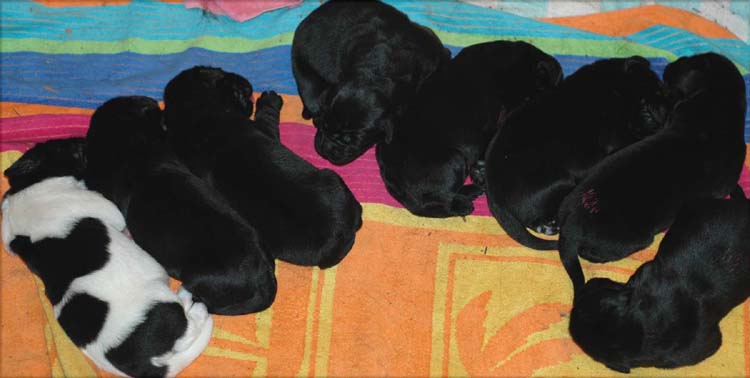
And then they’re sound asleep. Clean, comfortable, and eminently contented.